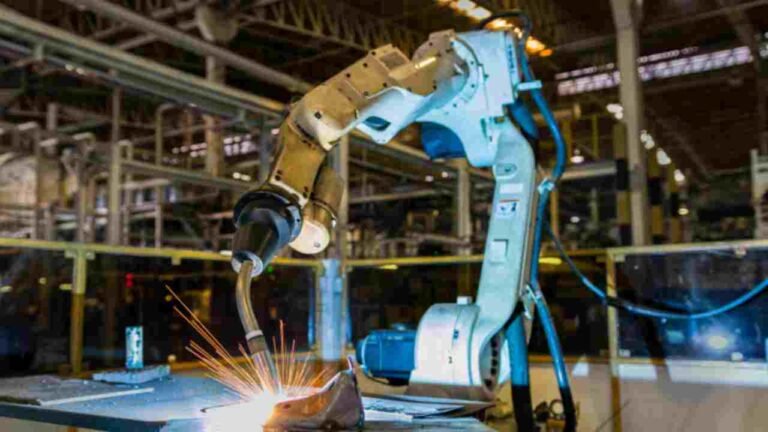1. Introduction to Robotics in Manufacturing
The integration of robotics in manufacturing has revolutionized the industry by making production processes more efficient, reducing human error, and improving overall quality. As robots continue to evolve, their role in the manufacturing sector is becoming increasingly critical. From assembly lines to packaging, robotics is playing a central role in optimizing production while significantly reducing the reliance on manual labor.
Key Features:
- Enhanced production efficiency
- Reduction in human error
- Increased precision in manufacturing processes
2. Automating Repetitive Tasks: Reducing Manual Labor
Robotics has greatly reduced the need for human labor in repetitive and physically demanding tasks. Robots can perform tasks like welding, material handling, and assembly without the fatigue and errors associated with human workers. For example, robotic arms can continuously work on repetitive assembly tasks, increasing speed while maintaining high levels of precision and quality.
Key Features:
- Automation of repetitive tasks
- Increased production speed and consistency
- Elimination of fatigue and human error
3. Increased Precision and Quality Control
Robots are designed for high precision, which is particularly valuable in manufacturing where consistency and quality are paramount. Advanced robots are now capable of performing intricate assembly and testing operations with accuracy that far surpasses human capabilities. This ensures that products meet strict quality standards and reduces the need for post-production corrections.
Key Features:
- Precision assembly and testing
- Reduced defect rates and waste
- Consistent product quality
4. Flexible Manufacturing Systems: Adaptability in Production
Unlike traditional manufacturing systems, robotic systems are highly adaptable and can be easily reprogrammed to handle different tasks. This flexibility allows manufacturers to quickly switch between production runs and scale operations without major downtime. Whether it’s changing a product’s design or shifting production to meet demand, robotics can make these transitions seamless and efficient.
Key Features:
- Easy reprogramming for different tasks
- Quick transition between production runs
- Scalability without significant downtime
5. Reducing Operational Costs: The ROI of Robotics
Though the initial investment in robotics can be significant, the long-term return on investment (ROI) is undeniable. Robots help reduce labor costs by performing tasks that would otherwise require multiple workers. Additionally, their ability to work continuously without breaks or errors means higher productivity levels and cost savings. Over time, companies see a reduction in labor-related expenses, maintenance costs, and waste.
Key Features:
- Reduced labor costs
- Lower maintenance and downtime
- High return on investment (ROI) over time
6. Enhancing Worker Safety: Reducing Risk and Injury
In many manufacturing environments, employees are exposed to hazardous conditions such as heavy machinery, high temperatures, and repetitive motions. By integrating robots into dangerous tasks, manufacturers are protecting their workers from the risk of injury. Robots can take on jobs such as handling hazardous materials or working with dangerous equipment, improving overall workplace safety.
Key Features:
- Automation of dangerous and hazardous tasks
- Reduction in workplace injuries and accidents
- Improved worker safety and health
7. Robotics in Packaging and Sorting: Optimizing Logistics
Robots are also playing a significant role in packaging and sorting operations. Automated systems can rapidly and accurately sort products, package them, and prepare them for distribution with minimal human intervention. For example, robots can pick, pack, and ship products much faster than manual labor, improving efficiency and reducing the time it takes to get products to market.
Key Features:
- Automated packaging and sorting
- Faster product handling and shipment
- Reduced labor requirements in logistics
8. Collaborative Robots (Cobots): Human-Robot Synergy
One of the most exciting developments in the world of robotics is the advent of collaborative robots (cobots). Unlike traditional robots that work in isolation, cobots are designed to work alongside human workers. Cobots assist with physically demanding tasks, allowing humans to focus on tasks that require creativity, decision-making, and complex problem-solving. This collaboration reduces physical strain on workers while increasing overall productivity.
Key Features:
- Collaboration between robots and human workers
- Assistance with physically demanding tasks
- Enhanced productivity and reduced strain on workers
9. Robotics in Maintenance: Predicting and Preventing Downtime
Robotic systems are not just improving production; they are also contributing to proactive maintenance. Through the use of predictive analytics and AI, robots can monitor the performance of machines and predict when maintenance is needed, preventing unexpected breakdowns. By identifying potential issues early, manufacturers can reduce downtime and improve operational efficiency.
Key Features:
- Predictive maintenance through AI
- Early identification of potential equipment issues
- Reduced downtime and maintenance costs
10. The Future of Robotics in Manufacturing: AI and Beyond
The future of robotics in manufacturing is promising, with AI integration pushing the boundaries of automation. As robots become smarter and more autonomous, they will be able to make real-time decisions based on data, enhancing flexibility, adaptability, and efficiency. Future advancements may include robots capable of self-repair, self-optimization, and even collaborative decision-making with human workers, further revolutionizing the manufacturing process.
Key Features:
- AI-driven robots for real-time decision-making
- Autonomous robots capable of self-optimization
- Advanced collaboration between robots and humans
Conclusion
Robotics is making manufacturing more efficient, less labor-intensive, and safer for workers. From automating repetitive tasks to ensuring higher levels of precision, robots are playing an increasingly crucial role in modern production lines. With their ability to reduce operational costs, improve quality control, and enhance safety, robotics is transforming the manufacturing landscape, offering companies the ability to scale operations while maintaining high productivity and quality standards.

